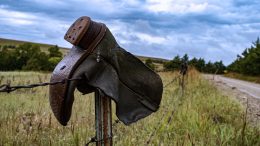Are we ushering in a new era of manifest destiny — and ultimately celebrating our own demise?
America was raised on the ideology of rugged individualism, grit, and the mirage of freedom on a conquered landscape.
Pop culture embodied this ideology as the gunslinging cowboy, who through more than a century’s worth of Western films, books, and TV shows — from Gunsmoke (1955) and Bonanza (1959) to Yellowstone (2018) — rode across the screen and lassoed American hearts. We’ve been primed to believe the American cowboy is a hero and a violent showdown is the best self-defense, the ultimate path to our freedom.
The only thing more American may be a cheeseburger — and not coincidentally, they’re inextricably linked.
The quick-shooting, horseback-riding lone ranger perseveres in the American imagination and symbolizes some of our deeply held values. That romance has evolved and shaped public perception of the modern-day, glorified livestock rancher.
Meanwhile cultural enchantment with the cowboy myth has lined the pockets of private interests at taxpayers’ expense, influenced policy, and proudly allowed for unfettered damage to our environment.
As we bear witness to the dismantling of significant public services in our nation and unchecked government greed directed at cashing in on public lands, is the rugged individualism of the cowboy fantasy really what we want to hold onto as Americans?
The Myth of the Self-Made Rancher
As an associate journalist interning with the Wild Narrative Project, a nonprofit outlet that explores the impacts of private interests on public lands and wildlife, I learned firsthand how powerful entities like livestock operations sway public policy and opinion in their favor.
While the cowboy myth proclaims that success on a new frontier is defined by personal grit and defiant autonomy, the reality is that ranchers depend on generous subsidies from government agencies like the U.S. Department of Agriculture. And we taxpayers largely foot the bill.
To the backdrop of growing inflation for the average American, it costs less for ranchers to graze their cattle than it did in 1981. Ranchers fatten their cows for profit on public lands for a mere $1.35 per animal unit month. This “unit month” equates to the amount of forage needed to sustain a cow and her calf — or five sheep — for an entire month. One dollar and thirty-five cents.
The cost to taxpayers, however, is exponential. A 2022 study found that between management and the social cost of greenhouse gas emissions, private livestock grazing on federal public lands costs U.S. taxpayers more than $608 million every year.
Other studies show the government spends up to $38 billion each year to subsidize meat and dairy industries. Talk about government inefficiency.
Out of our own pockets, we pay for the environmental damage caused by grazing — and then pay ranchers’ insurance for disaster relief. It’s a vicious, costly circle.
Big Agriculture reaps the benefits of meager output while taxpayers pick up the slack and pay high prices at the grocery store on top of it. The idea that prices for consumers will fall if we protect access to the small family farm is out of reach when the top players control the market.
The environmental nonprofit Western Watersheds Project calls subsidized cattle-grazing programs “welfare” — even more poignant in an era where welfare programs are villainized by a government that wants to put more money into the pockets of the wealthy and eliminate programs that contribute to the greater good.
Not coincidentally, livestock ranchers’ significant perks aren’t on the chopping block.
The Impact on Environmental Progress
The proposition that cowboys — or real-life ranchers — are stewards of the land and caretakers of animals is deeply flawed.
Wealthy ranchers have spent $523 million dollars lobbying Congress over the past five years to slant policy in their favor, in part to exempt themselves from environmental regulations.
California’s Sonoma County recently witnessed the enduring strength of cowboy myth and the power of rancher money in politics. Last year Measure J — a contentious and groundbreaking effort initiated by Direct Action Everywhere, an international network of animal-rights activists, to end factory farming in Sonoma County — received a landslide defeat at the ballot box following an extensive marketing campaign by the No on J PAC.
No on J contributions — which largely came from Western United Dairies, Petaluma Poultry Processors, Clover Sonoma, and Weber Family Farms — totaled more than $1.7 million and allowed opponents to outspend the organizers who put Measure J on the ballot by a substantial margin.
Incorporated agriculture entities were able to persuade the public that Measure J would hurt the local economy and generations of small family farmers — because they had the resources to spend on spinning that narrative.
The measure did not aim to end family farming. It sought to phase out 21 identified Concentrated Animal Feeding Operations with a long history of violating animal cruelty laws. Beyond fighting for animal welfare, the organizers also sought to improve water quality, public health, and allow smaller farmers to flourish where corporate farms had monopolized.
But instead, ‘No on J’ signs remain on some open land where cattle roam, urging the community to “protect the local farmer” more than six months after the measure lost by 85%. The ranchers are idolized, while some activists face prison time for removing animals from factory farms as part of their efforts to expose cruelty and disease.
Even as ranchers use the law against activists, one of the true features of (some) cowboys is lawlessness. Notorious rancher Cliven Bundy bullied the Bureau of Land Management and refused to play by the rules — and a standoff occurred when armed supporters stood behind him in his refusal to pay grazing fees or remove his cattle from closed allotments.
Years later his son Ammon Bundy is a wanted fugitive. Not only was Ammon Bundy an active participant in the armed standoff with his father but later he rounded up another mob of militants in an attempt to take control of federal land, demanding a national wildlife refuge be handed over to the ranchers. He led a hate-filled campaign against a hospital, and then, to evade his convictions, he went on the run.
Cattle ranchers like the Bundys aim to intimidate ecologists, wildlife biologists, and others who seek to heal the eroded land that cattle has damaged for decades.
Agriculture uses up half of the world’s habitable land and accounts for 70% of freshwater withdrawals. These are lands and waters that sustain life for countless species who play vital roles in our ecosystems, not just humans and livestock.
Livestock have massively reduced biodiversity. Today farm animals like cows, sheep, goats and pigs account for 62% of mammal biomass throughout the entire world, in contrast to humans at 34% and wild mammals at a staggeringly low 4%.
The New Era of Manifest Destiny
In this new era of manifest destiny, Doug Burgum, the recently appointed secretary of the Interior, and the rest of the Trump administration see public lands as something to be conquered for profit.
The administration’s disdain for the scientific evidence of climate change and the harm done by Big Ag reflects the violent, individualist values of the cowboy in old Westerns.
At many points throughout our history, the villain has been rewritten as the hero and compassion vilified. In that kind of sociopolitical climate, mass genocide and irreparable harm to the land have been justified, accelerated, and praised. We’re witnessing another such moment now.
The removal of “red-tape” — the emergency executive orders to expand logging in our national forests, livestock grazing on public lands, and other plans to “unleash the power of American energy” while actively deregulating environmental policies — is likely to exacerbate climate change and threaten the habitats of several thousand species.
An abundance of evidence shows that cattle being raised en masse for human consumption degrade the Earth, but that reality gets buried by a public infatuation with the cowboy figure and ranchers’ heavy-handed lobby money.
But if the ranching industry continues to lobby against environmental policy, isn’t it inevitably lobbying against its own survival?
Scientists, Indigenous peoples, and activists have been sounding the alarm — it’s time for us to listen. It’s time for us all to weed through the distraction of political polarization and focus on taking care of each other and the planet. Idolizing the cowboy, however subconsciously, is hurting us more than it’s upholding the freedom for which it claims to stand.

Previously in The Revelator:
Livestock Grazing on Public Lands: The Perils of “Multiple Use”


